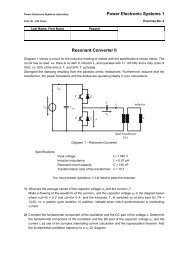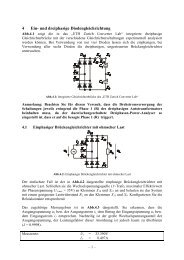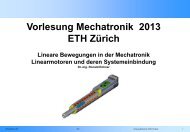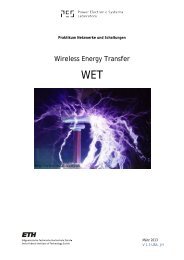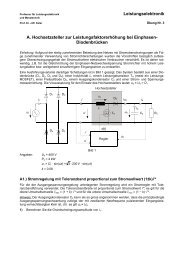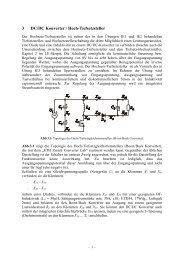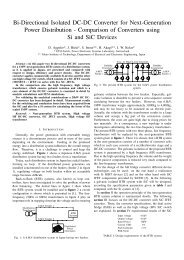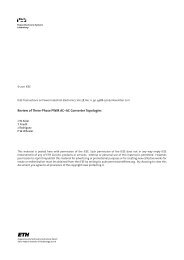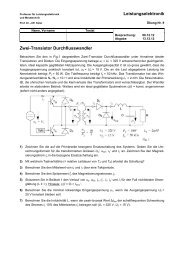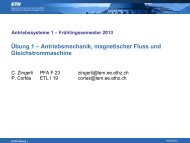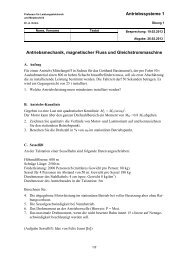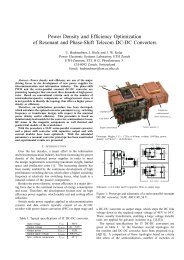HF Characterization and Non-Linear Modeling of a Gapped Toroidal ...
HF Characterization and Non-Linear Modeling of a Gapped Toroidal ...
HF Characterization and Non-Linear Modeling of a Gapped Toroidal ...
You also want an ePaper? Increase the reach of your titles
YUMPU automatically turns print PDFs into web optimized ePapers that Google loves.
<strong>HF</strong> <strong>Characterization</strong> <strong>and</strong> <strong>Non</strong>-<strong>Linear</strong> <strong>Modeling</strong><br />
<strong>of</strong> a <strong>Gapped</strong> <strong>Toroidal</strong> Magnetic Structure<br />
L. Daless<strong>and</strong>ro ∗ ,W.G.Odendaal † ,J.W.Kolar ∗<br />
∗ Swiss Federal Institute <strong>of</strong> Technology (ETH) Zurich<br />
Power Electronics Systems Laboratory<br />
ETH-Zentrum / ETL I14, CH-8092 Zurich, Switzerl<strong>and</strong><br />
E-mail: daless<strong>and</strong>ro@lem.ee.ethz.ch, kolar@lem.ee.ethz.ch<br />
† Virginia Polytechnic Institute <strong>and</strong> State University<br />
CPES (NSF Engineering Research Center for Power Electronics Systems)<br />
674 Whittemore Hall, Blacksburg VA 24060, USA<br />
E-mail: Hardus@IEEE.org<br />
Abstract— The frequency dependent characteristics <strong>of</strong> a gapped<br />
toroidal structure are extracted empirically over a b<strong>and</strong>width that exceeds<br />
30MHz. The analysis is complicated due to non-linear flux distributions,<br />
magnetic properties <strong>of</strong> the core material, leakage inductance, stray<br />
capacitances <strong>and</strong> eddy currents in the windings. A permeance model <strong>of</strong><br />
the core is implemented to model the magnetic circuit. The model includes<br />
a linear lumped element equivalent circuit to approximate the non-linear<br />
complex permeability <strong>of</strong> the core, which was measured empirically. Stray<br />
capacitance <strong>and</strong> inductance <strong>of</strong> the winding are also modeled. A gyrator<br />
is used to couple the electric <strong>and</strong> magnetic models for circuit simulation.<br />
The measured <strong>and</strong> simulated results <strong>of</strong> open-circuit impedance from the<br />
secondary winding <strong>and</strong> the transimpedance gain (V/A) <strong>of</strong> the current<br />
sensor are compared <strong>and</strong> discussed.<br />
I. INTRODUCTION<br />
The wide-b<strong>and</strong> characteristics <strong>of</strong> passive components are becoming<br />
increasingly important even for high power applications, for which<br />
there have been a steady increase in switching frequencies over recent<br />
years. Modern circuit simulation s<strong>of</strong>tware running on present microprocessors<br />
are more able to cope with high frequencies, <strong>and</strong> enable<br />
tighter control b<strong>and</strong>width. The ability to predict conducted EMI in<br />
power electronics circuitry before even constructing a prototype has<br />
also become a reality. These are only some <strong>of</strong> the reasons why<br />
high frequency behavior will gain increasing interest for the accurate<br />
characterization, modeling <strong>and</strong> design <strong>of</strong> circuit components, such as<br />
filters, inductors, capacitors <strong>and</strong> sensors, for frequencies typically up<br />
to 30MHz.<br />
Current transformers with high frequency b<strong>and</strong>widths are <strong>of</strong> special<br />
interest, since they are widely used in EMC compliance testing<br />
to inject disturbances as well as in power electronics circuits with<br />
high switching frequencies <strong>and</strong> wide-b<strong>and</strong> control functions [1]. This<br />
manuscript investigates the high frequency behavior <strong>of</strong> a gapped<br />
toroidal magnetic structure which is intended for a current sensor<br />
application. In practice the application includes a Hall-effect element,<br />
which is physically positioned in the air-gap as shown in Fig. 1,<br />
for dc <strong>and</strong> low frequency components <strong>of</strong> the measured current.<br />
The higher frequencies, to which the Hall-sensor is insensitive,<br />
are detected magnetically. The magnetic structure, which will be<br />
considered herein, thus consists <strong>of</strong> a toroidal core with an air-gap,<br />
a single-turn primary passing through the center window <strong>of</strong> the<br />
core, <strong>and</strong> a multi-turn secondary winding connected to the detection<br />
circuitry via a small load resistor. Even though this is in principle a<br />
rather simple structure, its behavior at high frequencies is affected by<br />
Fig. 1. Prototype <strong>of</strong> DC-broadb<strong>and</strong> CT showing the wound toroid with a<br />
Hall-element positioned in the air gap.<br />
several factors that can produce highly non-linear response signals.<br />
Firstly, a large air-gap (necessitated by the physical dimensions<br />
<strong>of</strong> the Hall-element) in a toroidal core produces a large distribution<br />
<strong>of</strong> fringing flux that leaks through the window <strong>of</strong> the core instead <strong>of</strong><br />
passing through the air gap. This irregular distribution <strong>of</strong> flux depends<br />
on the winding arrangement. Secondly, the core characteristics become<br />
non-linear due to the frequency-dependent behavior <strong>of</strong> the ferrite<br />
core. At higher frequencies rotational magnetic losses dominate,<br />
<strong>and</strong> the dielectric properties <strong>of</strong> the material play in increasing role.<br />
Lastly, the secondary winding itself exhibits enough stray capacitance<br />
<strong>and</strong> stray inductance to affect performance, notwithst<strong>and</strong>ing the<br />
internal impedances which give rise to a substantial higher resistance<br />
due to eddy current effects. The complexity <strong>of</strong> its behavior due to the<br />
combination <strong>of</strong> the above effects does not only affect the modeling<br />
<strong>of</strong> the structure, but also its empirical characterization. In [2] the<br />
difficulties <strong>and</strong> trade-<strong>of</strong>fs associated with wide-b<strong>and</strong> characterization<br />
<strong>of</strong> a current probe by means <strong>of</strong> frequency domain, S-parameter testing<br />
<strong>and</strong> time domain testing were discussed. In this study a lumped<br />
element model is extracted using impedance measurements <strong>and</strong> the<br />
dominating design parameters that dictate broadb<strong>and</strong> performance are<br />
also identified. A permeances model <strong>of</strong> the core is implemented to<br />
model the magnetic circuit <strong>and</strong> stray capacitance <strong>and</strong> inductance <strong>of</strong><br />
the winding are also included. The model includes a linear lumped<br />
element equivalent circuit to approximate the non-linear complex<br />
permeability <strong>of</strong> the core, which was measured experimentally. A set
<strong>of</strong> gyrators is used to couple the electric <strong>and</strong> magnetic models for<br />
circuit simulation.<br />
6000<br />
II. CORE MATERIAL CHARACTERIZATION<br />
A. Measurement <strong>of</strong> Complex Permeability<br />
4000<br />
μ'<br />
R s<br />
2000<br />
L s<br />
0<br />
a) b)<br />
Fig. 2. (a) Fully wound thin toroid for the measurement <strong>of</strong> complex<br />
permeability <strong>and</strong> (b) its equivalent circuit.<br />
2000<br />
10 4 10 5 10 6 10 7 10 8<br />
f [Hz]<br />
Complete material information over a broad frequency b<strong>and</strong>width<br />
is not always available. Therefore the measurement <strong>of</strong> the fundamental<br />
ferrite parameters, i.e. permeability, permittivity <strong>and</strong> conductivity<br />
must <strong>of</strong>ten be performed by the magnetic designers themselves. For<br />
this aim, specific material samples must be used. The complex relative<br />
permeability μ r = μ ′ − jμ ′′ can be extracted by measuring the<br />
reactance <strong>of</strong> a thin toroidal core (cf. Fig. 2). Since the dimensional<br />
effects influence this kind <strong>of</strong> measurement, the core cross-section<br />
should be sufficiently small [3]–[5]. Moreover, the windings on the<br />
sample core should ideally wrap fully around the circumference <strong>of</strong> the<br />
toroid. This uniform winding reduces the amount <strong>of</strong> flux that leaves<br />
the core <strong>and</strong> forces a more uniform flux density distribution in the<br />
core. The impedance Z <strong>of</strong> an N-turn inductor L can be represented at<br />
any given frequency ω/2π by the series combination <strong>of</strong> a resistance,<br />
R s, <strong>and</strong> a reactance, jωL s.<br />
( ) N 2 A e<br />
jωL = jωμ oμ r<br />
l e<br />
( ) N<br />
= jωμ o(μ ′ − jμ ′′ 2 A e<br />
)<br />
l e<br />
( ) ( )<br />
μoμ ′ N 2 A e<br />
μoμ ′′ N 2 A e<br />
= jω<br />
+2πf<br />
l e l e<br />
= jωL s + R s (1)<br />
where A e is the effective core cross section <strong>and</strong> l e is the mean flux<br />
path length. The values <strong>of</strong> equivalent series circuit parameters R s<br />
<strong>and</strong> L s can be measured directly using an impedance analyzer. The<br />
real <strong>and</strong> imaginary parts <strong>of</strong> the complex relative permeability are then<br />
obtained from:<br />
( )<br />
μ ′ l e<br />
(f) = L s(f)<br />
(2)<br />
μ oN 2 A e<br />
(<br />
)<br />
μ ′′ l e<br />
(f) = R s(f)<br />
(3)<br />
2πfμ oN 2 A e<br />
A R4 toroidal core <strong>of</strong> N30 ferrite, having dimensions d ext = 4 mm,<br />
d int = 2.4 mm, h = 1.6 mm, was used for the measurement. This<br />
thin toroid was fully wound with N= 22 turns. The impedance was<br />
measured with an AGILENT A294A Precision Impedance Analyzer<br />
with an oscillation level <strong>of</strong> 0.5 mA. The results shown in Fig. 3 are in<br />
good agreement with similar measurements obtained for larger cores<br />
[6].<br />
μ"<br />
1600<br />
1200<br />
800<br />
400<br />
0<br />
10 4 10 5 10 6 10 7 10 8<br />
f [Hz]<br />
Fig. 3. Frequency plot <strong>of</strong> the real <strong>and</strong> imaginary parts, μ ′ <strong>and</strong> μ ′′ respectively<br />
<strong>of</strong> the complex relative permeability for N30 ferrite at 25 ◦ C.<br />
B. Prototype Construction<br />
The magnetic cores selected for the measurements were R16<br />
toroidal cores <strong>of</strong> N30 ferrite. Two designs were prototyped for testing;<br />
one having an air gap <strong>of</strong> 1.6mm <strong>and</strong> another without an air gap as<br />
showninFig.4.<br />
Fig. 4. Prototypes <strong>of</strong> the broadb<strong>and</strong> DC-CT. Ungapped toroids were used<br />
for empirical characterization.
φ ext<br />
i ext<br />
a) b)<br />
φ ext<br />
i ext<br />
c) d)<br />
Fig. 5. Effect <strong>of</strong> an external magnetic field for different winding arrangements<br />
on toroidal magnetic cores. The cross sectional area <strong>of</strong> flux linkage in (a)<br />
becomes smaller if a conductor is returned to the starting position as shown<br />
in (b). This loop area reduces further if the return conductor is wound as<br />
shown in (c). For a gapped toroid, such as in (d), the arrangement must be<br />
repeated twice.<br />
C. Winding Arrangement<br />
High immunity against external fields is important especially for<br />
current measurement applications. The winding arrangement must<br />
therefore be chosen carefully so that any external magnetic fields<br />
will not influence the sensor accuracy [7]. If a traditional winding<br />
is realized, as in Fig. 5(a), then the area linked with the external<br />
magnetic field is about equal to the internal circumference <strong>of</strong> the<br />
toroid. If one <strong>of</strong> the two terminals is returned back along the outer<br />
circumference <strong>of</strong> the toroid, then the loop area is reduced as in Fig.<br />
5(b). This solution is usually used for realizing Rogowski coils [8]–<br />
[10]. If the return conductor is also wound as in Fig. 5(c), then the<br />
loop area is further reduced. For a gapped toroid, this latter winding<br />
strategy can be realized as shown in Fig. 5(d).<br />
The secondaries <strong>of</strong> the protoypes consisted <strong>of</strong> 120 turns <strong>of</strong> 0.2mm<br />
magnet wire.<br />
III. MAGNETIC MODELING USING PERMEANCES<br />
The capacitance-permeance model [11]–[13] was chosen to model<br />
the rotational magnetization losses <strong>of</strong> the magnetic core. The model<br />
allows electrical simulation <strong>of</strong> a non-linear magnetic structure,<br />
through an analogous transformation <strong>of</strong> field quantities <strong>and</strong> the<br />
implementation <strong>of</strong> a gyrator. In an electrical analogous model, the<br />
relationship between capacitance <strong>and</strong> charge from<br />
dq<br />
dt = C dv<br />
(4)<br />
dt<br />
can be written as:<br />
C = dq<br />
(5)<br />
dv<br />
A permeances model is then constructed by defining the permeance,<br />
C m in henries per turn square as<br />
C m = dϕ<br />
(6)<br />
dψ<br />
φ ext<br />
φ ext<br />
i ext<br />
i ext<br />
The MMF per turn, ψ in ampéres is used analogous to the voltage<br />
in an electrical equivalent, whereas the induced voltage per turn, ξ<br />
in wb/s, is used analogous to the current:<br />
ξ = dϕ<br />
(7)<br />
dt<br />
This model is easily verified by exp<strong>and</strong>ing (6):<br />
C m = ∂B · S<br />
∂H · l = μ∂B · S<br />
(8)<br />
∂B · l<br />
If normal uniform field distributions are assumed in the media<br />
considered, then the permeance is the reciprocal <strong>of</strong> the reluctance<br />
analogy:<br />
C m = μS = R −1<br />
l<br />
where l is the flux pathlenght <strong>and</strong> S is the cross sectional area.<br />
A gyrator is implemented to link the equivalent magnetic circuit<br />
to the electrical domain:<br />
ψ = Ni<br />
v = Nξ (9)<br />
In a circuit simulator the magnetic circuit can thus be constructed<br />
using capacitor elements to represent all <strong>of</strong> the permeances. In the<br />
magnetic domain, the flux path may be broken into series capacitor<br />
elements representing permeances, whereas the flux cross section may<br />
be broken into parallel capacitor elements representing permeances.<br />
For instance, a core with an air gap is modeled as a capacitor<br />
for the core permeance in series with a capacitor representing the<br />
permeance <strong>of</strong> the air gap. The connection to the electrical circuit<br />
can then be represented by the Tellegen gyrator according to (9),<br />
comprising a controlled voltage source producing ψ (in series with<br />
the two capacitors), <strong>and</strong> another controlled voltage source producing<br />
the electrical voltage.<br />
A. <strong>Modeling</strong> the <strong>Non</strong>-<strong>Linear</strong> Magnetic Core<br />
If the frequency dependency <strong>of</strong> the ferrite core permeability is to<br />
be included in the model, then a simple curve fit may be implemented<br />
to approximate the complex permeability as a function <strong>of</strong> frequency.<br />
For frequencies up to 200MHz, the permeability is then approximated<br />
by assuming that<br />
χ 1 χ 2<br />
μ r(jω)=1+ +<br />
(10)<br />
1+jχ 1τ 1 1+jχ 2τ 2<br />
R 1<br />
R 2<br />
Fig. 6. Equivalent magnetic circuit for the complex permeability using linear<br />
lumped electrical elements.<br />
For a toroid having a cross section, A <strong>and</strong> a magnetic path length,<br />
l, the non-linear permeance <strong>of</strong> the core can be represented by a<br />
circuit comprising linear elements as shown in Fig. 6. For N30 ferrite,<br />
Table I lists the curve-fitted values that were obtained empirically <strong>and</strong><br />
subsequently used in the simulations.<br />
The relationship between this model <strong>and</strong> the parameters for complex<br />
permeability is treated in the Appendix.<br />
C o<br />
C 1<br />
C 2
TABLE I<br />
PARAMETERS FOR COMPLEX PERMEABILITY OF N30 FERRITE<br />
μ r<br />
permeance<br />
name value name value<br />
χ 1 2.621 × 10 3 C o 671.5pF<br />
χ 2 1.599 × 10 3 C 1 1.76μF<br />
τ 1 4.385 × 10 −11 C 2 1.074μF<br />
τ 2 6.943 × 10 −11 R 1 65mΩ<br />
R 2 103mΩ<br />
IV. EMPIRICAL CHARACTERIZATION OF THE PROTOTYPE<br />
CURRENT TRANSFORMER STRUCTURE<br />
A. Open Circuit Impedance<br />
The device under test is in essence a current transformer (CT)<br />
with a single conductor in the primary. A model for the secondary<br />
winding was extracted by measuring its output impedance with an<br />
open-circuited primary conductor still present. Rigorous methods for<br />
modeling winding impedances are given in [14], [15]. The measured<br />
<strong>and</strong> simulated results are plotted in Fig. 7 <strong>and</strong> the equivalent circuit<br />
for the simulation is depicted in Fig. 8. The lumped equivalent circuit<br />
model for the winding approximates the effects <strong>of</strong> winding stray<br />
capacitances, the winding leakage impedance <strong>and</strong> the high frequency<br />
ac resistance for the frequency range <strong>of</strong> interest. It can be extended<br />
to include higher order resonances that occur for frequencies beyond<br />
30MHz.<br />
B. Transimpedance Gain<br />
The primary was fed by a signal <strong>of</strong> constant amplitude over the<br />
frequency range 250 kHz to 30 MHz using a signal generator <strong>and</strong><br />
a power amplifier as shown in Fig. 9, <strong>and</strong> a list <strong>of</strong> the equipment<br />
is given in Table II. The primary <strong>of</strong> the CT consists <strong>of</strong> a custom<br />
designed coaxial construction that provides a constant resistance <strong>of</strong><br />
50Ω up to 30 MHz. It providces better stability over this frequency<br />
range <strong>and</strong> also matches the output impedance <strong>of</strong> the power amplifier.<br />
At each frequency, the primary (input) current amplitude I 1 <strong>and</strong> the<br />
i<br />
R w1<br />
C w1<br />
R C1<br />
L s<br />
R w2<br />
C w2<br />
N -N<br />
R C2<br />
R 1<br />
R 2<br />
C gap<br />
C 0<br />
C 1<br />
C 2<br />
R core<br />
10 6 f [Hz]<br />
10 5<br />
Fig. 8. Equivalent circuit with core permeances model <strong>and</strong> extracted winding<br />
impedances for simulating the output impedance measurement.<br />
Z [ Ω ]<br />
10 4<br />
10 3<br />
10 2<br />
10 1<br />
10 0<br />
10 1 10 2 10 3 10 4 10 5 10 6 10 7 10 8<br />
120<br />
Signal Generator<br />
Power Amplifier<br />
50Ω Coaxial Primary<br />
50mΩ Shunt<br />
Oscilloscope<br />
Voltage Probe<br />
TABLE II<br />
LIST OF EQUIPMENT<br />
Agilent 33250A 80MHz<br />
function/arbitrary waveform generator<br />
ENI 3200L RF Power Amplifier<br />
gain 55dB, 250kHz-150MHz<br />
custom design<br />
50MHz b<strong>and</strong>width<br />
T&M Research Products<br />
Model A-1-05, E max=20J<br />
LeCroy Waverunner LT584L<br />
1GHz<br />
LeCroy PP006A<br />
500MHz<br />
80<br />
phase [°]<br />
40<br />
0<br />
-40<br />
-80<br />
-120<br />
10 1 10 2 10 3 10 4 10 5 10 6 10 7 10 8<br />
f [Hz]<br />
Fig. 7. Plots <strong>of</strong> measured (solid line) <strong>and</strong> simulated (dashed line) output<br />
impedance.<br />
Fig. 9.<br />
Photograph <strong>of</strong> the experimental setup.
secondary (output) voltage amplitude U L across the load resistor R L<br />
are measured, along with the time delay between the two signals i 1<br />
<strong>and</strong> u L, that provides the difference Δϕ between the phases <strong>of</strong> the<br />
measured signals. The ratio between output voltage <strong>and</strong> input current<br />
provides the transfer function (TF) as a transimpedance gain U L/I 1,<br />
while the phase <strong>of</strong> the TF is given by Δϕ.<br />
The equivalent circuit <strong>of</strong> the current transformer for the transimpedance<br />
gain simulation is shown in Fig. 11. It includes the core<br />
permeances model for the non-linear core, the equivalent winding<br />
impedance, <strong>and</strong> the two Tellegen gyrators for the secondary winding<br />
<strong>and</strong> the single-turn primary winding.<br />
One <strong>of</strong> the advantages <strong>of</strong> the equivalent permeance core model is<br />
the ability to compute core losses directly by measuring the power<br />
dissipation <strong>of</strong> the resistors in the magnetic circuit. These losses are<br />
tabulated for a 10A excitation <strong>of</strong> the primary in Table III.<br />
V. DISCUSSION OF RESULTS<br />
Each circuital parameter used to model the gapped toroid has a<br />
specific physical meaning <strong>and</strong> influences the frequency behavior <strong>of</strong><br />
the overall device to some degree according to the frequency <strong>of</strong> the<br />
exciting signal. In particular, the slope <strong>of</strong> the impedance curve in<br />
Fig. 7 depends mainly on the value <strong>of</strong> the air gap permeance C gap,<br />
since most <strong>of</strong> the magnetic field concentrates in the air gap. The first<br />
Gain [ V/A ]<br />
10 -2<br />
TABLE III<br />
LOSS BREAKDOWN AT 100KHZ<br />
Part <strong>of</strong> Circuit<br />
10A in Primary<br />
mW<br />
Source Impedance 71<br />
R core 6.3<br />
Core <strong>Non</strong>-<strong>Linear</strong> Network 0.7<br />
Load 63<br />
Winding 1.6<br />
peak is provided by the parallel resonance between the magnetizing<br />
inductance <strong>and</strong> the winding self-capacitance, the second peak is given<br />
by the series resonance between winding leakage inductance L s <strong>and</strong><br />
self-capacitance <strong>and</strong> the third peak by the parallel resonance between<br />
L s <strong>and</strong> winding self-capacitance. The damping associated with the<br />
second <strong>and</strong> third resonance peaks in the impedance plot, as well as<br />
the damping associated with the resonant peak in the transimpedance<br />
gain curve (cf. Fig. 10), are modeled by the two large resistors R C1<br />
<strong>and</strong> R C2. In fact, the core shunt capacitances, C w1 <strong>and</strong> C w2, cannot<br />
simply be grounded since a ferrite material is a poor conductor <strong>and</strong><br />
the resistors account for the high resistivity <strong>of</strong> the ferrite.<br />
When the transimpedance gain is calculated (cf. Fig. 11), then<br />
the equivalent circuit remains the same except for the introduction<br />
<strong>of</strong> another gyrator that accounts for the primary <strong>and</strong> the secondary,<br />
which is then closed across a load resistor R L. A small capacitor<br />
between the Tellegen gyrators takes into account leakage flux in the<br />
core window that reduces the coupling between the primary conductor<br />
<strong>and</strong> the secondary winding. It is well known that the expression<br />
<strong>of</strong> the transimpedance gain <strong>of</strong> a transformer for low frequency, i.e.<br />
neglecting all <strong>HF</strong> effects <strong>and</strong> stray capacitance is<br />
( )<br />
U L<br />
sM<br />
= R L (11)<br />
I 1 R L + sL<br />
10 0 f [Hz]<br />
10 -1 10 3 10 4 10 5 10 6 10 7 10 8<br />
10 -3<br />
100<br />
0<br />
where L is the self-inductance <strong>of</strong> the secondary <strong>and</strong> M is the mutual<br />
inductance between primary <strong>and</strong> secondary [16]. If there is good<br />
magnetic coupling between primary <strong>and</strong> secondary, which is typical<br />
for a toroid, then M/L equals the ratio <strong>of</strong> primary to secondary turns.<br />
Accordingly the low corner frequency <strong>and</strong> the transimpedance gain<br />
are defined respectively as<br />
f L = RL<br />
2πL<br />
(12)<br />
phase [°]<br />
-100<br />
-200<br />
u L<br />
R L<br />
R w1<br />
C w1<br />
L s<br />
R w2<br />
C w2<br />
e<br />
N -N<br />
R 1<br />
R 2<br />
R C1<br />
R C2<br />
C 0<br />
C 1<br />
C 2<br />
-300<br />
C L<br />
-400<br />
10 3 10 4 10 5 10 6 10 7 10 8<br />
f [Hz]<br />
i 1<br />
1 -1<br />
C gap<br />
R core<br />
Fig. 10. The measured (solid line) <strong>and</strong> simulated (dashed line) results <strong>of</strong> the<br />
transimpedance gain <strong>of</strong> the current transformer.<br />
Fig. 11.<br />
Equivalent circuit for the current transformer.
a)<br />
a)<br />
10 -5<br />
10 -6<br />
10 -7<br />
10 -8<br />
10 -4 x [mm]<br />
B [T]<br />
10 - 5<br />
10 - 6<br />
10 -9<br />
-8 -4 0 4 8<br />
b)<br />
10 - 4 x [mm]<br />
B [T]<br />
10 - 7<br />
-8 -4 0 4 8<br />
b)<br />
Fig. 12. (a) Magnetic flux distribution for the inductor excited by a MMF<br />
<strong>of</strong> 10A at 100 kHz <strong>and</strong> (b) The magnetic flux density B along the x-axis.<br />
Fig. 13. (a) Magnetic flux distribution for the current transformer excited<br />
by a primary current <strong>of</strong> 10A at 100 kHz <strong>and</strong> (b) the magnetic flux density B<br />
along the x-axis.<br />
<strong>and</strong><br />
∣ ∣ ∣∣∣ U L ∣∣∣<br />
= RL<br />
(13)<br />
I 1 N<br />
For this case study these values correspond to f L = 2.27 kHz <strong>and</strong><br />
|U L/I 1| =83mΩ, whereL = 700μH, R L =10Ω <strong>and</strong> N = 120 turns.<br />
These theoretical values have been verified by the proposed transfer<br />
function model (cf. Fig. 10). If the coupling is not ideal, then the<br />
self inductance <strong>of</strong> the secondary L <strong>and</strong> the mutual inductance M are<br />
not proportional to one another. Therefore, the presence <strong>of</strong> a small<br />
capacitance, C L between the Tellegen gyrators accounts for the nonideal<br />
coupling. Accordingly the transimpeance gain will be lower <strong>and</strong><br />
provided by the general expression<br />
∣ ( )<br />
∣∣∣ ∣ UL M<br />
= R L (14)<br />
I 1 L<br />
Since the leakage inductance L s is proportional to N 2 <strong>and</strong> the<br />
winding self capacitance C is proportional to N, reducing the number<br />
<strong>of</strong> turns N should extend the frequency b<strong>and</strong>. The drawback <strong>of</strong><br />
this solution is that the self inductance L will also decrease, thus<br />
increasing the lower corner frequency.<br />
The value <strong>of</strong> the load resistor R L plays a crucial role in current<br />
transformers. Firstly, both the lower corner frequency <strong>and</strong> the transimpedance<br />
gain depend on R L.IfR L is increased, then a lower<br />
amplitude current will flow in the secondary, since the impressed<br />
e.m.f. (electro motive force) sMI 1 remains the same. Therefore the<br />
MMF due to the secondary current will compensate just part <strong>of</strong> the<br />
magnetic field associated with the primary current. The magnetic field<br />
density <strong>and</strong> flux line distribution for the inductor are shown in Fig.<br />
12. The compensation <strong>of</strong> the primary magnetic field by the one in<br />
Z [ Ω ]<br />
10 3<br />
10 2<br />
10 1<br />
10 0<br />
10 -1<br />
10 -2<br />
10 -3<br />
10 2 10 3 10 4 10 5 10 6 10 7 10 8<br />
f [Hz]<br />
R L<br />
1 M<br />
10 k<br />
100<br />
10<br />
Fig. 14. Frequency behavior as a function <strong>of</strong> the value <strong>of</strong> the load resistor<br />
R L <strong>of</strong> the open loop secondary winding voltage or flux derivative or current in<br />
the magnetic circuit over a sinusoidal excitation <strong>of</strong> 1A. In particular, the curve<br />
for R L =1MΩ provides the measured open loop impedance, just rescaled<br />
by the turn ratio. The curves were derived by using the equivalent circuit <strong>of</strong><br />
the current transformer.<br />
the secondary is evident by examining Fig. 13, where the device<br />
operates in the flat part (100kHz) <strong>of</strong> its frequency response. For large<br />
values <strong>of</strong> the load resistor or even for open secondary, the primary<br />
MMF is not compensated. The flux in the core is basically given<br />
by the primary MMF <strong>and</strong> the device behaves just like an inductor.
Gain [ Ω ]<br />
10 3<br />
10 2<br />
10 1<br />
10 0<br />
10 -1<br />
10 -2<br />
10 -3<br />
10 2 10 3 10 4 10 5 10 6 10 7 10 8<br />
f [Hz]<br />
R L<br />
1 M<br />
10 k<br />
100<br />
10<br />
Fig. 15. Transimpedance gain <strong>of</strong> the current transformer as a function <strong>of</strong><br />
the value <strong>of</strong> the load resistor R L . In particular, the curve for R L = 10Ω<br />
corresponds to the case study. The curves are derived by using the equivalent<br />
circuit <strong>of</strong> the current transformer.<br />
The magnetizing inductance assumes therefore a larger value <strong>and</strong><br />
the frequency plots in Figs. 14-15 show a prominent first parallel<br />
resonance due to the large magnetizing inductance. If R L is small,<br />
then more current will flow in the secondary. Ideally its amplitude<br />
should be equal to the primary current scaled by the turns ratio.<br />
In this case, the magnetizing inductance is very small due to flux<br />
cancellation so that the resultant flux within the transformer core<br />
is negigible. Consequently for small values <strong>of</strong> R L, the magnetizing<br />
inductance will have no major influence on the frequency behavior,<br />
as is clearly evident from the curves in Figs. 14-15.<br />
Fig. 14 depicts the voltage e (cf. Fig. 11) impressed across the<br />
secondary winding for a sinusoidal excitation <strong>of</strong> 1A. The voltage<br />
e is equal to the flux derivative, which is equivalent to the current<br />
flowing in the magnetic loop. In other words, this curve represents the<br />
impedance <strong>of</strong> the secondary winding rescaled by the turn ratio, since<br />
it is the primary which is being fed. In particular, the impedance<br />
plot in Fig. 7 corresponds to one <strong>of</strong> the curves in Fig. 14, which<br />
was obtained for the largest value <strong>of</strong> the load resistor. Moreover,<br />
the influence <strong>of</strong> the magnetizing inductance or <strong>of</strong> the resulting<br />
magnetic flux on the shape <strong>of</strong> the impedance frequency plot is directly<br />
apparent from the plots. The results <strong>of</strong> a similar procedure for the<br />
transimpedance gain are depicted in Fig. 15.<br />
VI. CONCLUSIONS<br />
This investigation <strong>of</strong> a gapped toroidal magnetic structure for<br />
a current sensor dealt with its design, empirical characterization,<br />
parameter extraction <strong>and</strong> modeling over a wide frequency b<strong>and</strong>width<br />
up to 30MHz. In the current sensing application, the Hall-effect<br />
sensor provides the low-frequency signal, whereas current transformer<br />
action is utilized for the high frequencies. A winding arrangement<br />
was presented which desensitizes the probe to the effects <strong>of</strong> external<br />
magnetic fields. The complex permeability <strong>of</strong> the magnetic core<br />
material was measured <strong>and</strong> the non-linear behavior <strong>of</strong> the magnetic<br />
core was then modeled by using a permeance model, which also<br />
accounts for the core losses. The output impedance was measured<br />
<strong>and</strong> all <strong>of</strong> the parameters associated with winding stray capacitances,<br />
leakage impedance <strong>and</strong> high frequency winding resistance were<br />
extracted for a lumped linear element equivalent circuit that could be<br />
linked to the magnetic permeances model via two Tellegen gyrators.<br />
The results from these open circuit measurements were compared to<br />
simulated results <strong>and</strong> good agreement was shown. A good agreement<br />
was also obtained between the measured transimpedance gain <strong>of</strong><br />
the current transformer <strong>and</strong> simulated results there<strong>of</strong> using the same<br />
models for core permeances <strong>and</strong> winding impedances. The influence<br />
<strong>of</strong> the load resistance in the secondary circuit on the transimpedance<br />
gain was also investigated empirically <strong>and</strong> numerically.<br />
The upper b<strong>and</strong>width limit <strong>of</strong> the probe is mostly dependent on<br />
the winding impedances, in particular the stray winding capacitances<br />
[17], <strong>and</strong> this was also verified in simulations. The permeance model<br />
allows access to the flux rate <strong>and</strong> the MMF in parts <strong>of</strong> the toroidal<br />
core, which provided further valuable information about the magnetic<br />
behavior <strong>of</strong> the magnetic structure. Since a resistance element in the<br />
permeance model represents magnetic losses (unlike the conventional<br />
magnetic reluctance model where resistance represents energy storage),<br />
core losses could also be extracted using this method.<br />
The modeling procedure for a gapped toroidal current sensor<br />
that is presented herein demonstrates high accuracy for both the<br />
winding impedance <strong>and</strong> the trans-impedance gain. From a practical<br />
st<strong>and</strong>point, accurate measurement <strong>of</strong> the transfer function <strong>of</strong> a current<br />
transformer requires much more effort than measuring only its<br />
winding impedance, <strong>and</strong> the characterization <strong>of</strong> a two port device<br />
is generally more complicated than for a one port device. Since<br />
the winding impedance measurement <strong>and</strong> the characterization <strong>of</strong><br />
the ferrite material allows extraction <strong>of</strong> all the parameters <strong>of</strong> the<br />
equivalent circuit <strong>of</strong> the current sensor electrically <strong>and</strong> magnetically,<br />
information about the transfer function <strong>of</strong> the component can be<br />
derived without having to perform any further two port measurements.<br />
VII. APPENDIX<br />
R 1<br />
R 2<br />
Fig. 16. Equivalent magnetic circuit for the complex permeability using<br />
linear lumped electrical elements.<br />
Fig. 16 depicts the equivalent lumped element circuit for representing<br />
the frequency-dependent complex permeability <strong>of</strong> the core,<br />
<strong>and</strong> is repeated here for convenience. The complex permeability is<br />
assumed to obey the function:<br />
χ 1 χ 2<br />
μ r(jω)=1+ +<br />
(15)<br />
1+jχ 1τ 1 1+jχ 2τ 2<br />
The admittance <strong>of</strong> this circuit in the frequency domain is:<br />
Y (jω)=jω μ0μr(jω)A = jωC oμ r(jω)<br />
l<br />
= Y o(jω)μ r(jω) (16)<br />
where:<br />
C o = μ0A<br />
(17)<br />
l<br />
Since C o can be calculated directly from the geometry, the other<br />
four parameters are more easilly obtained by subtracting this value:<br />
C o<br />
C 1<br />
C 2
=<br />
Y (jω) − Y o(jω) Y (jω) − jωCo<br />
= = μ r(jω) − 1<br />
Y o(jω)<br />
jωC<br />
(<br />
o<br />
)<br />
C 1/C o<br />
1+jω( C 1<br />
C o<br />
)( R 1<br />
C o<br />
) + C 2/C o<br />
(18)<br />
1+jω( C 2<br />
C o<br />
)( R 2<br />
C o<br />
)<br />
By inspection, all <strong>of</strong> the equivalent circuit element values are then<br />
identified as follows:<br />
C 1 = χ 1C o<br />
C 2 = χ 2C o<br />
τ 1 = χ 1R 1<br />
τ 2 = χ 2R 2<br />
The values <strong>of</strong> χ 1, χ 2, τ 1 <strong>and</strong> τ 2 can also be obtained by a simple<br />
method involving graphical inspection <strong>of</strong> measuremed data <strong>of</strong> the<br />
complex permeability. Equation (10) can be simplified:<br />
where:<br />
μ r(jω) − 1 =<br />
=<br />
χ 1<br />
1+jχ 1τ 1<br />
+<br />
χ 2<br />
1+jχ 2τ 2<br />
χ1 + χ2 + jωχ1χ2 (τ1 + τ2)<br />
(1 + jωχ 1τ 1)(1+jωχ 2τ 2)<br />
= A o<br />
1+jω/ω 12<br />
(1 + jω/ω 1)(1+jω/ω 2)<br />
A o = χ 1 + χ 2<br />
ω 1 = (χ 1τ 1) −1<br />
(19)<br />
ω 2 = (χ 2τ 2) −1<br />
ω 12 =<br />
χ 1 + χ 2<br />
χ 1χ 2(τ 1 + τ 2)<br />
=<br />
A o<br />
χ 2<br />
ω 1<br />
+ χ 1<br />
ω 2<br />
(20)<br />
The approximate values <strong>of</strong> ω 1, ω 2 <strong>and</strong> ω 12 can be determined<br />
graphically by identifying asymptotes in a bode plot <strong>of</strong> the measured<br />
μ r − 1.<br />
The plot <strong>of</strong> the complex relative permeability <strong>of</strong> N30 ferrite<br />
indicates that it is fair to assume that ω 1



